The Role of Harm in Criminal Victimization
VerifiedAdded on 2023/03/17
|12
|3175
|54
AI Summary
This essay discusses the role of 'harm' in the construction of criminal victimization and the impact of social divisions on criminal harm. It explores various methodologies used to study victims and victimization, as well as the different types of criminal victimizations. The essay also highlights the importance of considering social harm in relation to victimization and the influence of media in shaping perceptions of crime victims.
Contribute Materials
Your contribution can guide someone’s learning journey. Share your
documents today.

Running head: CRIMINOLOGY
CRIMINOLOGY
Name of Student
Name of University
Author Note
CRIMINOLOGY
Name of Student
Name of University
Author Note
Secure Best Marks with AI Grader
Need help grading? Try our AI Grader for instant feedback on your assignments.

1CRIMINOLOGY
In this essay the role of ‘harm’ in the construction of criminal victimization would be
discussed along with the impact of social divisions on criminal harm. The term ‘harm’ is defined
in the oxford dictionary as deliberately inflicted physical injury. The term victimization can be
described as the process of becoming a victim. Anyone can be a victim of a crime irrespective of
their gender, age, race or ethnicity and it may happen to an individual, a family, a group or even
to a community as a crime to a person or a property.
There are various methodologies, tools and techniques used to find out about the victims,
crimes and victimization. Two broad approaches of researching and uncovering victimization are
identified as- counting and measuring using quantitative survey methodologies, and observing to
various qualitative approaches. Another broad approach of researching victims is the study of
victims and victimization within theoretical and political context. Victimization can be a result of
both criminal and non-criminal harms. According to the United Nations Declaration of Basic
Principles of Justice for Victims of Crime and Abuse of Power, people can not only be
victimized as a result of crime but also because of the abuse of economic and political power.
However the main focus of this paper is criminal victimization and the role of harm in its
construction.
Victimization can be defined as the process of being victimized that is being treated
intentionally in an unfair way. There are various types of criminal victimizations namely, sexual
misconduct, physical assault, domestic violence, threat of harm, rape and theft.
It is ensured by victimology that the victims of crimes and social harm, survivors of
abuse and injustice receive academic and scholarly attention and exposure to policy makers,
practitioners and state officials (Hillyard et al., 2004, 2005)
In this essay the role of ‘harm’ in the construction of criminal victimization would be
discussed along with the impact of social divisions on criminal harm. The term ‘harm’ is defined
in the oxford dictionary as deliberately inflicted physical injury. The term victimization can be
described as the process of becoming a victim. Anyone can be a victim of a crime irrespective of
their gender, age, race or ethnicity and it may happen to an individual, a family, a group or even
to a community as a crime to a person or a property.
There are various methodologies, tools and techniques used to find out about the victims,
crimes and victimization. Two broad approaches of researching and uncovering victimization are
identified as- counting and measuring using quantitative survey methodologies, and observing to
various qualitative approaches. Another broad approach of researching victims is the study of
victims and victimization within theoretical and political context. Victimization can be a result of
both criminal and non-criminal harms. According to the United Nations Declaration of Basic
Principles of Justice for Victims of Crime and Abuse of Power, people can not only be
victimized as a result of crime but also because of the abuse of economic and political power.
However the main focus of this paper is criminal victimization and the role of harm in its
construction.
Victimization can be defined as the process of being victimized that is being treated
intentionally in an unfair way. There are various types of criminal victimizations namely, sexual
misconduct, physical assault, domestic violence, threat of harm, rape and theft.
It is ensured by victimology that the victims of crimes and social harm, survivors of
abuse and injustice receive academic and scholarly attention and exposure to policy makers,
practitioners and state officials (Hillyard et al., 2004, 2005)
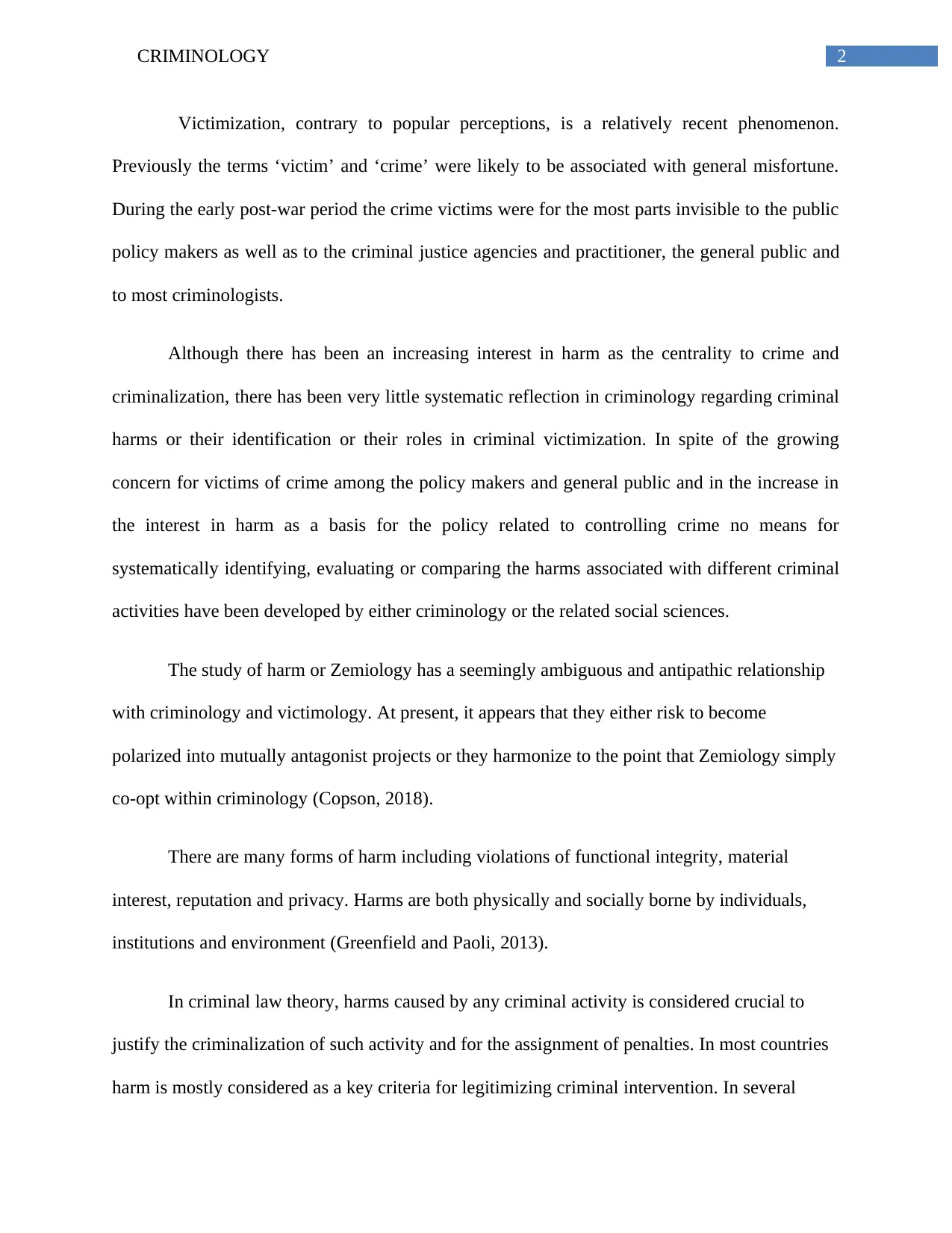
2CRIMINOLOGY
Victimization, contrary to popular perceptions, is a relatively recent phenomenon.
Previously the terms ‘victim’ and ‘crime’ were likely to be associated with general misfortune.
During the early post-war period the crime victims were for the most parts invisible to the public
policy makers as well as to the criminal justice agencies and practitioner, the general public and
to most criminologists.
Although there has been an increasing interest in harm as the centrality to crime and
criminalization, there has been very little systematic reflection in criminology regarding criminal
harms or their identification or their roles in criminal victimization. In spite of the growing
concern for victims of crime among the policy makers and general public and in the increase in
the interest in harm as a basis for the policy related to controlling crime no means for
systematically identifying, evaluating or comparing the harms associated with different criminal
activities have been developed by either criminology or the related social sciences.
The study of harm or Zemiology has a seemingly ambiguous and antipathic relationship
with criminology and victimology. At present, it appears that they either risk to become
polarized into mutually antagonist projects or they harmonize to the point that Zemiology simply
co-opt within criminology (Copson, 2018).
There are many forms of harm including violations of functional integrity, material
interest, reputation and privacy. Harms are both physically and socially borne by individuals,
institutions and environment (Greenfield and Paoli, 2013).
In criminal law theory, harms caused by any criminal activity is considered crucial to
justify the criminalization of such activity and for the assignment of penalties. In most countries
harm is mostly considered as a key criteria for legitimizing criminal intervention. In several
Victimization, contrary to popular perceptions, is a relatively recent phenomenon.
Previously the terms ‘victim’ and ‘crime’ were likely to be associated with general misfortune.
During the early post-war period the crime victims were for the most parts invisible to the public
policy makers as well as to the criminal justice agencies and practitioner, the general public and
to most criminologists.
Although there has been an increasing interest in harm as the centrality to crime and
criminalization, there has been very little systematic reflection in criminology regarding criminal
harms or their identification or their roles in criminal victimization. In spite of the growing
concern for victims of crime among the policy makers and general public and in the increase in
the interest in harm as a basis for the policy related to controlling crime no means for
systematically identifying, evaluating or comparing the harms associated with different criminal
activities have been developed by either criminology or the related social sciences.
The study of harm or Zemiology has a seemingly ambiguous and antipathic relationship
with criminology and victimology. At present, it appears that they either risk to become
polarized into mutually antagonist projects or they harmonize to the point that Zemiology simply
co-opt within criminology (Copson, 2018).
There are many forms of harm including violations of functional integrity, material
interest, reputation and privacy. Harms are both physically and socially borne by individuals,
institutions and environment (Greenfield and Paoli, 2013).
In criminal law theory, harms caused by any criminal activity is considered crucial to
justify the criminalization of such activity and for the assignment of penalties. In most countries
harm is mostly considered as a key criteria for legitimizing criminal intervention. In several
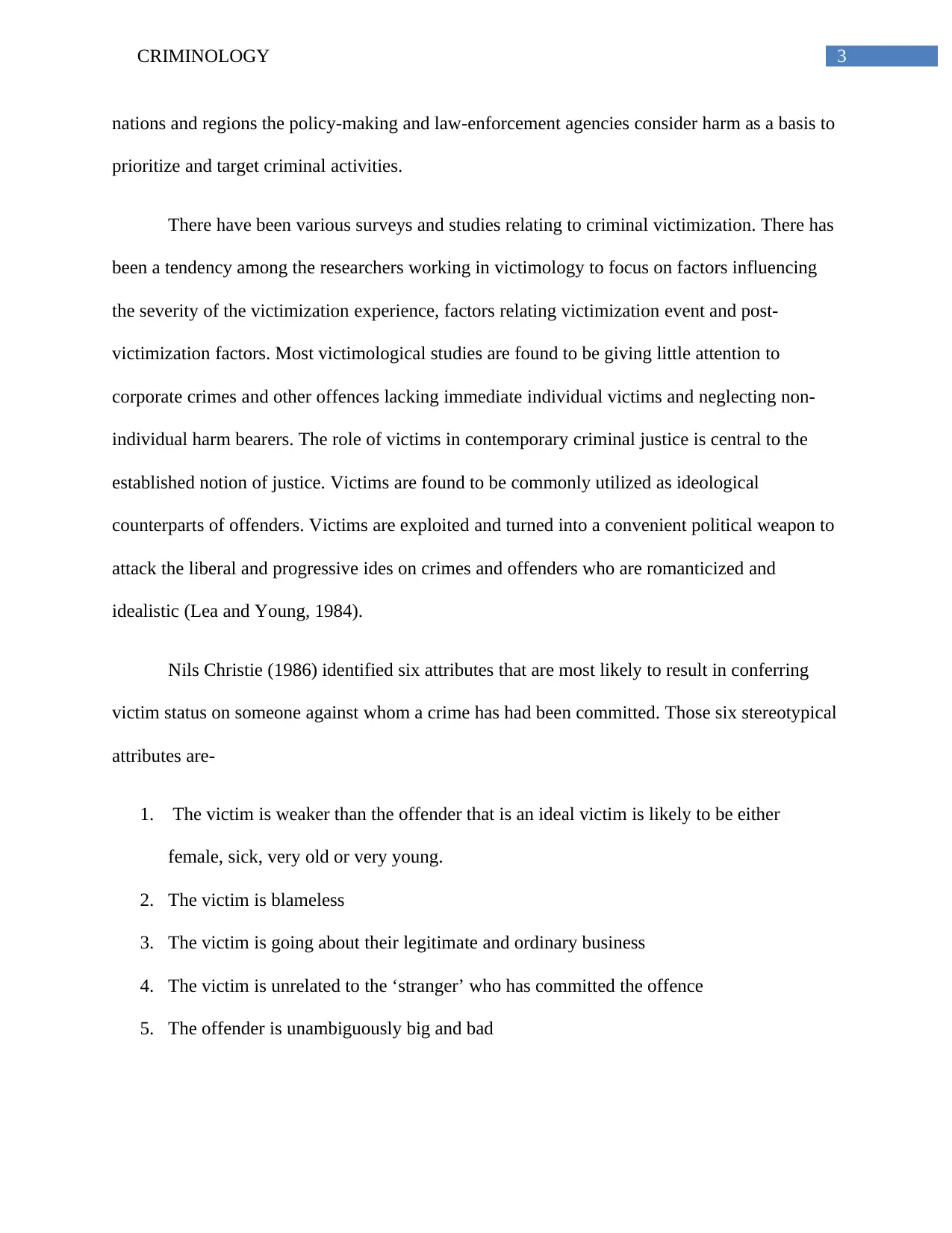
3CRIMINOLOGY
nations and regions the policy-making and law-enforcement agencies consider harm as a basis to
prioritize and target criminal activities.
There have been various surveys and studies relating to criminal victimization. There has
been a tendency among the researchers working in victimology to focus on factors influencing
the severity of the victimization experience, factors relating victimization event and post-
victimization factors. Most victimological studies are found to be giving little attention to
corporate crimes and other offences lacking immediate individual victims and neglecting non-
individual harm bearers. The role of victims in contemporary criminal justice is central to the
established notion of justice. Victims are found to be commonly utilized as ideological
counterparts of offenders. Victims are exploited and turned into a convenient political weapon to
attack the liberal and progressive ides on crimes and offenders who are romanticized and
idealistic (Lea and Young, 1984).
Nils Christie (1986) identified six attributes that are most likely to result in conferring
victim status on someone against whom a crime has had been committed. Those six stereotypical
attributes are-
1. The victim is weaker than the offender that is an ideal victim is likely to be either
female, sick, very old or very young.
2. The victim is blameless
3. The victim is going about their legitimate and ordinary business
4. The victim is unrelated to the ‘stranger’ who has committed the offence
5. The offender is unambiguously big and bad
nations and regions the policy-making and law-enforcement agencies consider harm as a basis to
prioritize and target criminal activities.
There have been various surveys and studies relating to criminal victimization. There has
been a tendency among the researchers working in victimology to focus on factors influencing
the severity of the victimization experience, factors relating victimization event and post-
victimization factors. Most victimological studies are found to be giving little attention to
corporate crimes and other offences lacking immediate individual victims and neglecting non-
individual harm bearers. The role of victims in contemporary criminal justice is central to the
established notion of justice. Victims are found to be commonly utilized as ideological
counterparts of offenders. Victims are exploited and turned into a convenient political weapon to
attack the liberal and progressive ides on crimes and offenders who are romanticized and
idealistic (Lea and Young, 1984).
Nils Christie (1986) identified six attributes that are most likely to result in conferring
victim status on someone against whom a crime has had been committed. Those six stereotypical
attributes are-
1. The victim is weaker than the offender that is an ideal victim is likely to be either
female, sick, very old or very young.
2. The victim is blameless
3. The victim is going about their legitimate and ordinary business
4. The victim is unrelated to the ‘stranger’ who has committed the offence
5. The offender is unambiguously big and bad
Secure Best Marks with AI Grader
Need help grading? Try our AI Grader for instant feedback on your assignments.

4CRIMINOLOGY
6. The victim has the right combination of power and influence or sympathy to successfully
gain victim status without threatening any vested interest.
There are certain theories related to the causes of victimisation. These are
proximity to crime, exposure to crime, target attractiveness and capable guardianship.
One of the central assumptions underlying victimization theories is that particualr targets
are selected because of having symbolic or economic values to the offenders. The major
measures of target attractiveness have been the ownership of expensive and portable consumer
goods, cash and jewellery (Sampson and Wooldredge, 1987; Miethe and Meier, 1990).
It is arguably important to go beyond crime and criminal justice related notions of
victimization and explore the contexts of social harms in relation to victimization. A focus on
social harm forces the study of victimology to consider the well-beings of human and the
necessities to achieve the well-being.
Contemporary societies are made up of heterogeneous populations that consists of people
holding diverse identities in relation to race, ethnicity, gender, age, sexuality, faith, disabilities
and class. Social categories are not static but rather dynamic and diverse. This diversity amongst
victims illustrates the importance of identity of victimization as a social harm in relation to inter
and intra-group conflict. Studies show that conflicts can lead to wide range individual or group
level impacts on human beings, including depression, anxiety, radicalization and stigmatization.
Researches further suggest that refugee populations and minority groups have higher levels
mental health and stress related issues as a result of everyday stigmatization and humiliation. In
focusing on the study of social harm with relation to victimization it allows everyone to look at
broader harms, whether those are defined as crime or not, people experience and further allows
6. The victim has the right combination of power and influence or sympathy to successfully
gain victim status without threatening any vested interest.
There are certain theories related to the causes of victimisation. These are
proximity to crime, exposure to crime, target attractiveness and capable guardianship.
One of the central assumptions underlying victimization theories is that particualr targets
are selected because of having symbolic or economic values to the offenders. The major
measures of target attractiveness have been the ownership of expensive and portable consumer
goods, cash and jewellery (Sampson and Wooldredge, 1987; Miethe and Meier, 1990).
It is arguably important to go beyond crime and criminal justice related notions of
victimization and explore the contexts of social harms in relation to victimization. A focus on
social harm forces the study of victimology to consider the well-beings of human and the
necessities to achieve the well-being.
Contemporary societies are made up of heterogeneous populations that consists of people
holding diverse identities in relation to race, ethnicity, gender, age, sexuality, faith, disabilities
and class. Social categories are not static but rather dynamic and diverse. This diversity amongst
victims illustrates the importance of identity of victimization as a social harm in relation to inter
and intra-group conflict. Studies show that conflicts can lead to wide range individual or group
level impacts on human beings, including depression, anxiety, radicalization and stigmatization.
Researches further suggest that refugee populations and minority groups have higher levels
mental health and stress related issues as a result of everyday stigmatization and humiliation. In
focusing on the study of social harm with relation to victimization it allows everyone to look at
broader harms, whether those are defined as crime or not, people experience and further allows

5CRIMINOLOGY
asking broader questions about how social justice can be achieved in an unequal society where
criminal justice is not guaranteed. It can be seen the transformations in the culture and economy
such as deindustrialization and globalization, have high impact upon social division. The four
main categories that happen to be the major social inequalities in the society are class, race, age
and gender. To be poor, black, young or female simultaneously represents different social
categories relative to different disadvantages, exclusion, marginalization and powerlessness. It
has also been revealed by the victim surveys that certain groups or individuals run a high risk of
being victimised. Moreover the burden of victimization is known to fall unevenly on individuals
even within the populations known to be mostly at risk (Genn, 1988; Trickett et al., 1995; Van
Dijk, 2000).
Various researchers identify crime and victimization as a ‘socially constructed’ problem.
Although this has been widely criticized but the contextual meaning of this sentence is since very
few people have a limited first-hand experience in criminal victimization, most people rely on
various other sources for their knowledge. Among the various sources only few are important
than media. Media representations contribute to shaping issues of crime, meanings of criminal
victimization and social harms to people. They present particular views of reality to construct
these issues. Research evidence makes it clear that news constructions tend to focus on particular
types of victims and victimization by being highly selective and unrepresentative (Gekoski et al.,
2012). Media interests in crime victims are at the greatest when they can be portrayed as the
‘ideal victim’ that is a person or category of individuals who are most readily given the complete
status of being a victim when hit by crime. Elderly women, young children are considered
typically to be the ideal victims, whereas young men, homeless, drug abusers and others existing
asking broader questions about how social justice can be achieved in an unequal society where
criminal justice is not guaranteed. It can be seen the transformations in the culture and economy
such as deindustrialization and globalization, have high impact upon social division. The four
main categories that happen to be the major social inequalities in the society are class, race, age
and gender. To be poor, black, young or female simultaneously represents different social
categories relative to different disadvantages, exclusion, marginalization and powerlessness. It
has also been revealed by the victim surveys that certain groups or individuals run a high risk of
being victimised. Moreover the burden of victimization is known to fall unevenly on individuals
even within the populations known to be mostly at risk (Genn, 1988; Trickett et al., 1995; Van
Dijk, 2000).
Various researchers identify crime and victimization as a ‘socially constructed’ problem.
Although this has been widely criticized but the contextual meaning of this sentence is since very
few people have a limited first-hand experience in criminal victimization, most people rely on
various other sources for their knowledge. Among the various sources only few are important
than media. Media representations contribute to shaping issues of crime, meanings of criminal
victimization and social harms to people. They present particular views of reality to construct
these issues. Research evidence makes it clear that news constructions tend to focus on particular
types of victims and victimization by being highly selective and unrepresentative (Gekoski et al.,
2012). Media interests in crime victims are at the greatest when they can be portrayed as the
‘ideal victim’ that is a person or category of individuals who are most readily given the complete
status of being a victim when hit by crime. Elderly women, young children are considered
typically to be the ideal victims, whereas young men, homeless, drug abusers and others existing
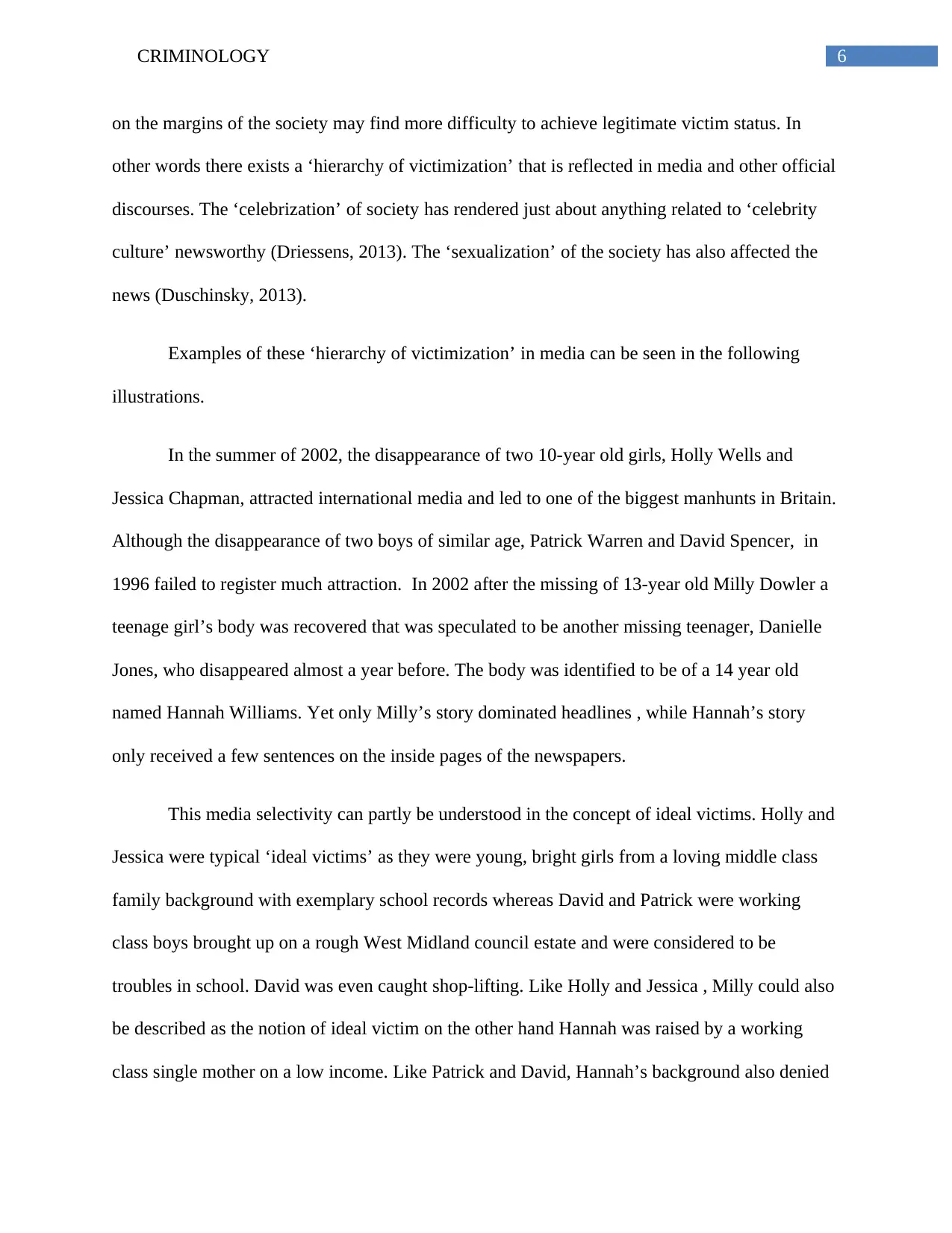
6CRIMINOLOGY
on the margins of the society may find more difficulty to achieve legitimate victim status. In
other words there exists a ‘hierarchy of victimization’ that is reflected in media and other official
discourses. The ‘celebrization’ of society has rendered just about anything related to ‘celebrity
culture’ newsworthy (Driessens, 2013). The ‘sexualization’ of the society has also affected the
news (Duschinsky, 2013).
Examples of these ‘hierarchy of victimization’ in media can be seen in the following
illustrations.
In the summer of 2002, the disappearance of two 10-year old girls, Holly Wells and
Jessica Chapman, attracted international media and led to one of the biggest manhunts in Britain.
Although the disappearance of two boys of similar age, Patrick Warren and David Spencer, in
1996 failed to register much attraction. In 2002 after the missing of 13-year old Milly Dowler a
teenage girl’s body was recovered that was speculated to be another missing teenager, Danielle
Jones, who disappeared almost a year before. The body was identified to be of a 14 year old
named Hannah Williams. Yet only Milly’s story dominated headlines , while Hannah’s story
only received a few sentences on the inside pages of the newspapers.
This media selectivity can partly be understood in the concept of ideal victims. Holly and
Jessica were typical ‘ideal victims’ as they were young, bright girls from a loving middle class
family background with exemplary school records whereas David and Patrick were working
class boys brought up on a rough West Midland council estate and were considered to be
troubles in school. David was even caught shop-lifting. Like Holly and Jessica , Milly could also
be described as the notion of ideal victim on the other hand Hannah was raised by a working
class single mother on a low income. Like Patrick and David, Hannah’s background also denied
on the margins of the society may find more difficulty to achieve legitimate victim status. In
other words there exists a ‘hierarchy of victimization’ that is reflected in media and other official
discourses. The ‘celebrization’ of society has rendered just about anything related to ‘celebrity
culture’ newsworthy (Driessens, 2013). The ‘sexualization’ of the society has also affected the
news (Duschinsky, 2013).
Examples of these ‘hierarchy of victimization’ in media can be seen in the following
illustrations.
In the summer of 2002, the disappearance of two 10-year old girls, Holly Wells and
Jessica Chapman, attracted international media and led to one of the biggest manhunts in Britain.
Although the disappearance of two boys of similar age, Patrick Warren and David Spencer, in
1996 failed to register much attraction. In 2002 after the missing of 13-year old Milly Dowler a
teenage girl’s body was recovered that was speculated to be another missing teenager, Danielle
Jones, who disappeared almost a year before. The body was identified to be of a 14 year old
named Hannah Williams. Yet only Milly’s story dominated headlines , while Hannah’s story
only received a few sentences on the inside pages of the newspapers.
This media selectivity can partly be understood in the concept of ideal victims. Holly and
Jessica were typical ‘ideal victims’ as they were young, bright girls from a loving middle class
family background with exemplary school records whereas David and Patrick were working
class boys brought up on a rough West Midland council estate and were considered to be
troubles in school. David was even caught shop-lifting. Like Holly and Jessica , Milly could also
be described as the notion of ideal victim on the other hand Hannah was raised by a working
class single mother on a low income. Like Patrick and David, Hannah’s background also denied
Paraphrase This Document
Need a fresh take? Get an instant paraphrase of this document with our AI Paraphraser
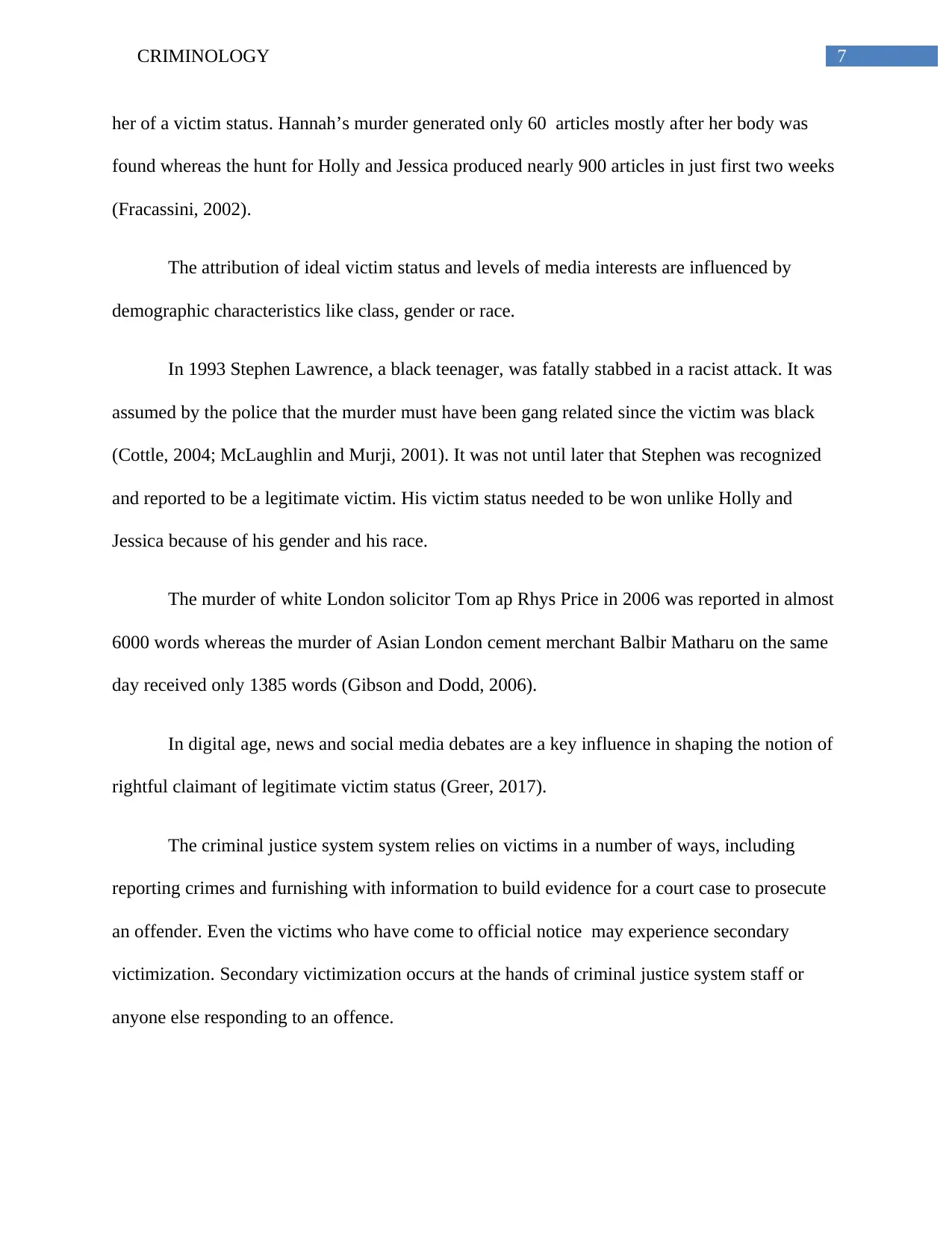
7CRIMINOLOGY
her of a victim status. Hannah’s murder generated only 60 articles mostly after her body was
found whereas the hunt for Holly and Jessica produced nearly 900 articles in just first two weeks
(Fracassini, 2002).
The attribution of ideal victim status and levels of media interests are influenced by
demographic characteristics like class, gender or race.
In 1993 Stephen Lawrence, a black teenager, was fatally stabbed in a racist attack. It was
assumed by the police that the murder must have been gang related since the victim was black
(Cottle, 2004; McLaughlin and Murji, 2001). It was not until later that Stephen was recognized
and reported to be a legitimate victim. His victim status needed to be won unlike Holly and
Jessica because of his gender and his race.
The murder of white London solicitor Tom ap Rhys Price in 2006 was reported in almost
6000 words whereas the murder of Asian London cement merchant Balbir Matharu on the same
day received only 1385 words (Gibson and Dodd, 2006).
In digital age, news and social media debates are a key influence in shaping the notion of
rightful claimant of legitimate victim status (Greer, 2017).
The criminal justice system system relies on victims in a number of ways, including
reporting crimes and furnishing with information to build evidence for a court case to prosecute
an offender. Even the victims who have come to official notice may experience secondary
victimization. Secondary victimization occurs at the hands of criminal justice system staff or
anyone else responding to an offence.
her of a victim status. Hannah’s murder generated only 60 articles mostly after her body was
found whereas the hunt for Holly and Jessica produced nearly 900 articles in just first two weeks
(Fracassini, 2002).
The attribution of ideal victim status and levels of media interests are influenced by
demographic characteristics like class, gender or race.
In 1993 Stephen Lawrence, a black teenager, was fatally stabbed in a racist attack. It was
assumed by the police that the murder must have been gang related since the victim was black
(Cottle, 2004; McLaughlin and Murji, 2001). It was not until later that Stephen was recognized
and reported to be a legitimate victim. His victim status needed to be won unlike Holly and
Jessica because of his gender and his race.
The murder of white London solicitor Tom ap Rhys Price in 2006 was reported in almost
6000 words whereas the murder of Asian London cement merchant Balbir Matharu on the same
day received only 1385 words (Gibson and Dodd, 2006).
In digital age, news and social media debates are a key influence in shaping the notion of
rightful claimant of legitimate victim status (Greer, 2017).
The criminal justice system system relies on victims in a number of ways, including
reporting crimes and furnishing with information to build evidence for a court case to prosecute
an offender. Even the victims who have come to official notice may experience secondary
victimization. Secondary victimization occurs at the hands of criminal justice system staff or
anyone else responding to an offence.
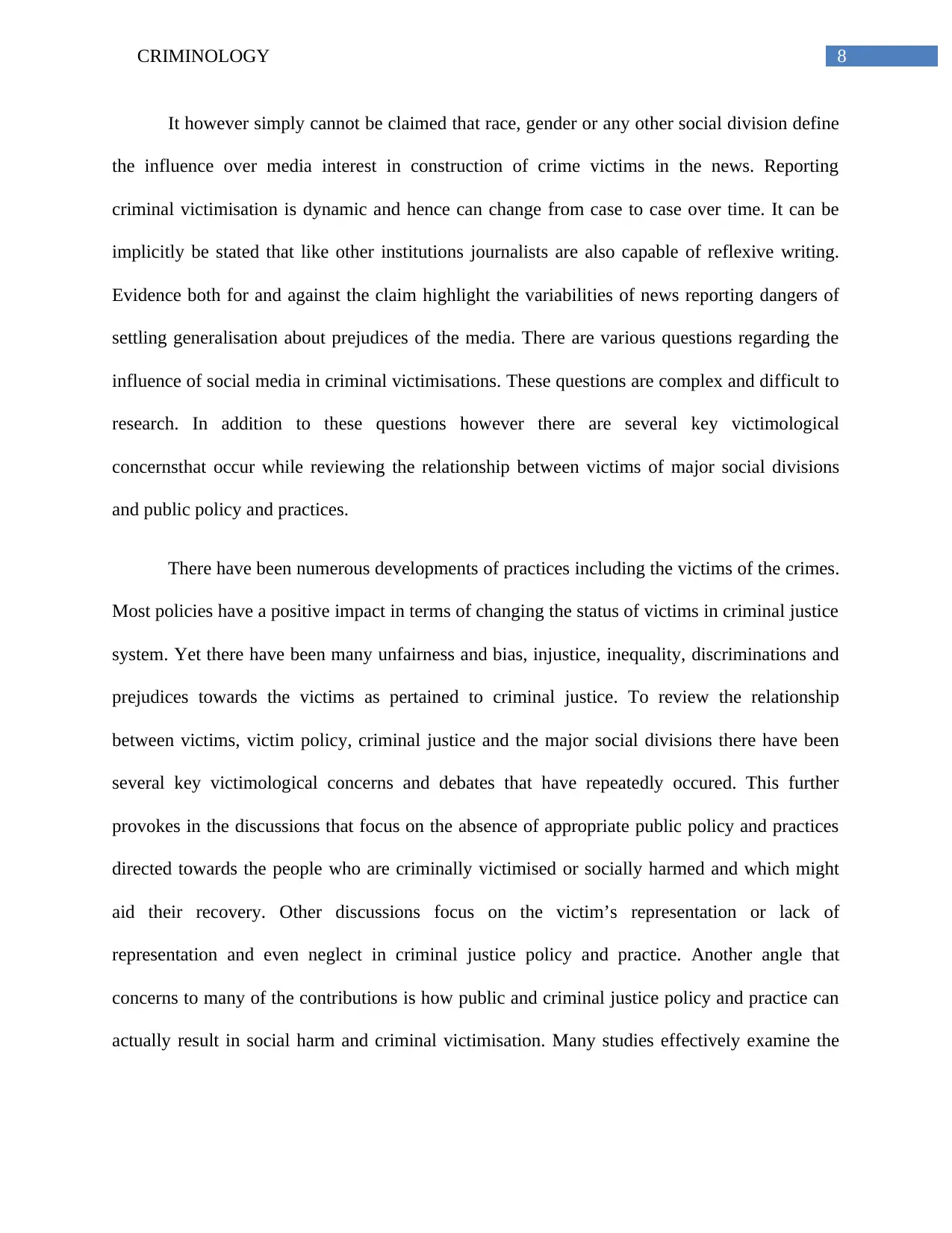
8CRIMINOLOGY
It however simply cannot be claimed that race, gender or any other social division define
the influence over media interest in construction of crime victims in the news. Reporting
criminal victimisation is dynamic and hence can change from case to case over time. It can be
implicitly be stated that like other institutions journalists are also capable of reflexive writing.
Evidence both for and against the claim highlight the variabilities of news reporting dangers of
settling generalisation about prejudices of the media. There are various questions regarding the
influence of social media in criminal victimisations. These questions are complex and difficult to
research. In addition to these questions however there are several key victimological
concernsthat occur while reviewing the relationship between victims of major social divisions
and public policy and practices.
There have been numerous developments of practices including the victims of the crimes.
Most policies have a positive impact in terms of changing the status of victims in criminal justice
system. Yet there have been many unfairness and bias, injustice, inequality, discriminations and
prejudices towards the victims as pertained to criminal justice. To review the relationship
between victims, victim policy, criminal justice and the major social divisions there have been
several key victimological concerns and debates that have repeatedly occured. This further
provokes in the discussions that focus on the absence of appropriate public policy and practices
directed towards the people who are criminally victimised or socially harmed and which might
aid their recovery. Other discussions focus on the victim’s representation or lack of
representation and even neglect in criminal justice policy and practice. Another angle that
concerns to many of the contributions is how public and criminal justice policy and practice can
actually result in social harm and criminal victimisation. Many studies effectively examine the
It however simply cannot be claimed that race, gender or any other social division define
the influence over media interest in construction of crime victims in the news. Reporting
criminal victimisation is dynamic and hence can change from case to case over time. It can be
implicitly be stated that like other institutions journalists are also capable of reflexive writing.
Evidence both for and against the claim highlight the variabilities of news reporting dangers of
settling generalisation about prejudices of the media. There are various questions regarding the
influence of social media in criminal victimisations. These questions are complex and difficult to
research. In addition to these questions however there are several key victimological
concernsthat occur while reviewing the relationship between victims of major social divisions
and public policy and practices.
There have been numerous developments of practices including the victims of the crimes.
Most policies have a positive impact in terms of changing the status of victims in criminal justice
system. Yet there have been many unfairness and bias, injustice, inequality, discriminations and
prejudices towards the victims as pertained to criminal justice. To review the relationship
between victims, victim policy, criminal justice and the major social divisions there have been
several key victimological concerns and debates that have repeatedly occured. This further
provokes in the discussions that focus on the absence of appropriate public policy and practices
directed towards the people who are criminally victimised or socially harmed and which might
aid their recovery. Other discussions focus on the victim’s representation or lack of
representation and even neglect in criminal justice policy and practice. Another angle that
concerns to many of the contributions is how public and criminal justice policy and practice can
actually result in social harm and criminal victimisation. Many studies effectively examine the

9CRIMINOLOGY
ways in which the victimisation as a result of criminal justice policy and practice can be aimed at
reducing crime and impropving quality of life and well-beings of the victims.
In conclusion it can be stated that a critical approach towards the victims of crime and
victimisation of crime in relation to harm, especially social harm has been made in this essay. It
has further identified the key influences shaping the construction of criminal victimisation in the
news media exploring the relationship between social devisions, inequality, ideal victim status,
and discussing various theories regarding victimisation.
ways in which the victimisation as a result of criminal justice policy and practice can be aimed at
reducing crime and impropving quality of life and well-beings of the victims.
In conclusion it can be stated that a critical approach towards the victims of crime and
victimisation of crime in relation to harm, especially social harm has been made in this essay. It
has further identified the key influences shaping the construction of criminal victimisation in the
news media exploring the relationship between social devisions, inequality, ideal victim status,
and discussing various theories regarding victimisation.
Secure Best Marks with AI Grader
Need help grading? Try our AI Grader for instant feedback on your assignments.
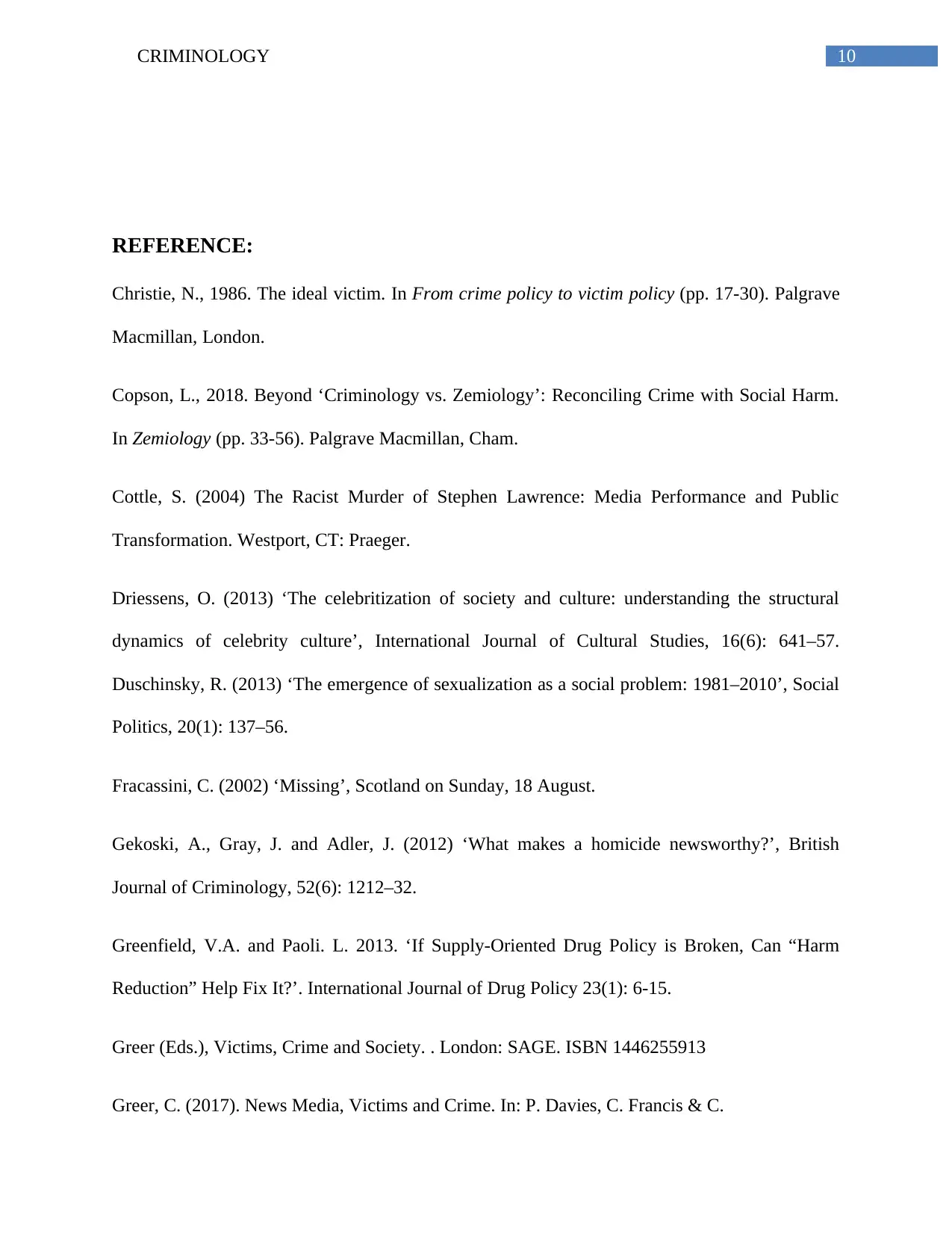
10CRIMINOLOGY
REFERENCE:
Christie, N., 1986. The ideal victim. In From crime policy to victim policy (pp. 17-30). Palgrave
Macmillan, London.
Copson, L., 2018. Beyond ‘Criminology vs. Zemiology’: Reconciling Crime with Social Harm.
In Zemiology (pp. 33-56). Palgrave Macmillan, Cham.
Cottle, S. (2004) The Racist Murder of Stephen Lawrence: Media Performance and Public
Transformation. Westport, CT: Praeger.
Driessens, O. (2013) ‘The celebritization of society and culture: understanding the structural
dynamics of celebrity culture’, International Journal of Cultural Studies, 16(6): 641–57.
Duschinsky, R. (2013) ‘The emergence of sexualization as a social problem: 1981–2010’, Social
Politics, 20(1): 137–56.
Fracassini, C. (2002) ‘Missing’, Scotland on Sunday, 18 August.
Gekoski, A., Gray, J. and Adler, J. (2012) ‘What makes a homicide newsworthy?’, British
Journal of Criminology, 52(6): 1212–32.
Greenfield, V.A. and Paoli. L. 2013. ‘If Supply-Oriented Drug Policy is Broken, Can “Harm
Reduction” Help Fix It?’. International Journal of Drug Policy 23(1): 6-15.
Greer (Eds.), Victims, Crime and Society. . London: SAGE. ISBN 1446255913
Greer, C. (2017). News Media, Victims and Crime. In: P. Davies, C. Francis & C.
REFERENCE:
Christie, N., 1986. The ideal victim. In From crime policy to victim policy (pp. 17-30). Palgrave
Macmillan, London.
Copson, L., 2018. Beyond ‘Criminology vs. Zemiology’: Reconciling Crime with Social Harm.
In Zemiology (pp. 33-56). Palgrave Macmillan, Cham.
Cottle, S. (2004) The Racist Murder of Stephen Lawrence: Media Performance and Public
Transformation. Westport, CT: Praeger.
Driessens, O. (2013) ‘The celebritization of society and culture: understanding the structural
dynamics of celebrity culture’, International Journal of Cultural Studies, 16(6): 641–57.
Duschinsky, R. (2013) ‘The emergence of sexualization as a social problem: 1981–2010’, Social
Politics, 20(1): 137–56.
Fracassini, C. (2002) ‘Missing’, Scotland on Sunday, 18 August.
Gekoski, A., Gray, J. and Adler, J. (2012) ‘What makes a homicide newsworthy?’, British
Journal of Criminology, 52(6): 1212–32.
Greenfield, V.A. and Paoli. L. 2013. ‘If Supply-Oriented Drug Policy is Broken, Can “Harm
Reduction” Help Fix It?’. International Journal of Drug Policy 23(1): 6-15.
Greer (Eds.), Victims, Crime and Society. . London: SAGE. ISBN 1446255913
Greer, C. (2017). News Media, Victims and Crime. In: P. Davies, C. Francis & C.
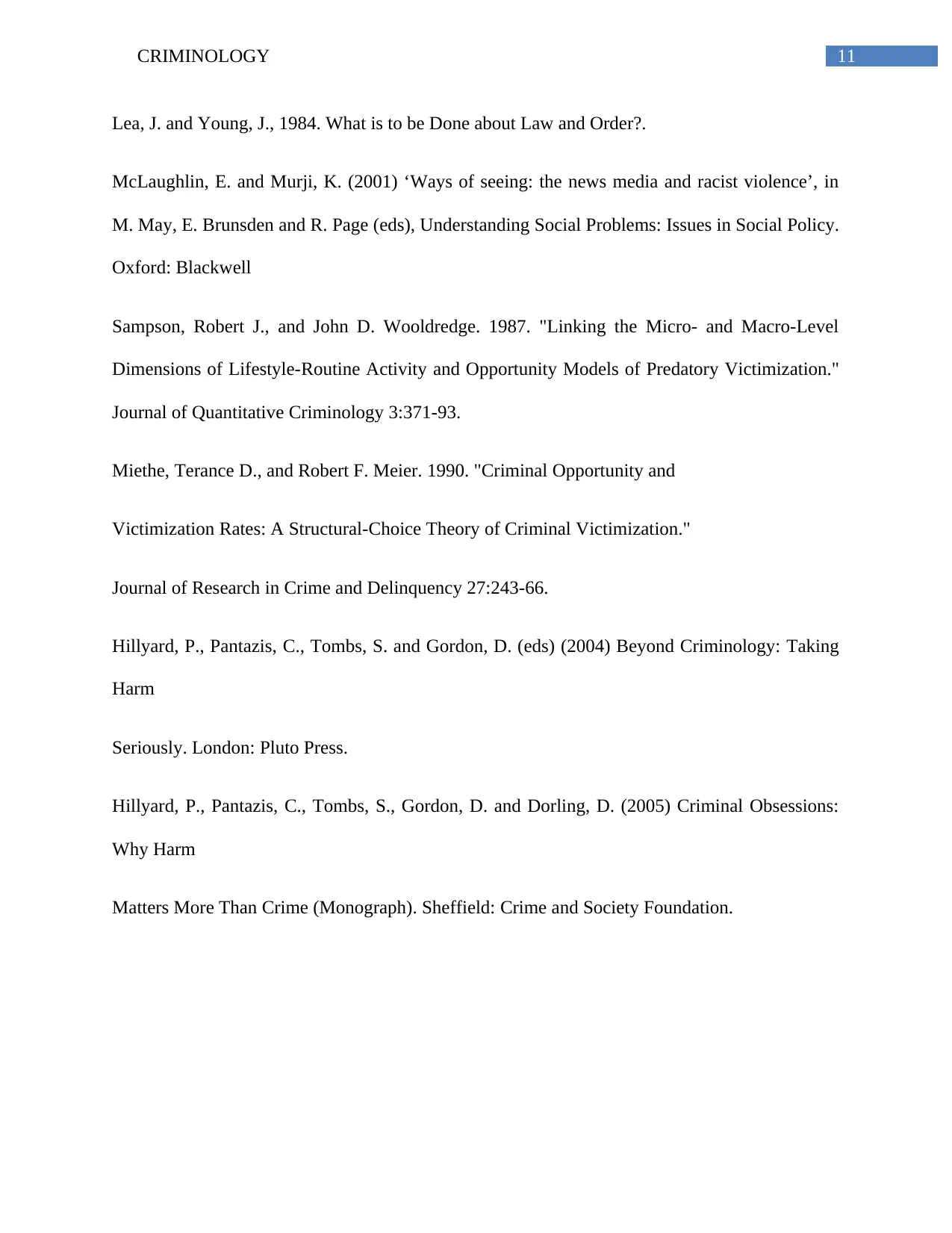
11CRIMINOLOGY
Lea, J. and Young, J., 1984. What is to be Done about Law and Order?.
McLaughlin, E. and Murji, K. (2001) ‘Ways of seeing: the news media and racist violence’, in
M. May, E. Brunsden and R. Page (eds), Understanding Social Problems: Issues in Social Policy.
Oxford: Blackwell
Sampson, Robert J., and John D. Wooldredge. 1987. "Linking the Micro- and Macro-Level
Dimensions of Lifestyle-Routine Activity and Opportunity Models of Predatory Victimization."
Journal of Quantitative Criminology 3:371-93.
Miethe, Terance D., and Robert F. Meier. 1990. "Criminal Opportunity and
Victimization Rates: A Structural-Choice Theory of Criminal Victimization."
Journal of Research in Crime and Delinquency 27:243-66.
Hillyard, P., Pantazis, C., Tombs, S. and Gordon, D. (eds) (2004) Beyond Criminology: Taking
Harm
Seriously. London: Pluto Press.
Hillyard, P., Pantazis, C., Tombs, S., Gordon, D. and Dorling, D. (2005) Criminal Obsessions:
Why Harm
Matters More Than Crime (Monograph). Sheffield: Crime and Society Foundation.
Lea, J. and Young, J., 1984. What is to be Done about Law and Order?.
McLaughlin, E. and Murji, K. (2001) ‘Ways of seeing: the news media and racist violence’, in
M. May, E. Brunsden and R. Page (eds), Understanding Social Problems: Issues in Social Policy.
Oxford: Blackwell
Sampson, Robert J., and John D. Wooldredge. 1987. "Linking the Micro- and Macro-Level
Dimensions of Lifestyle-Routine Activity and Opportunity Models of Predatory Victimization."
Journal of Quantitative Criminology 3:371-93.
Miethe, Terance D., and Robert F. Meier. 1990. "Criminal Opportunity and
Victimization Rates: A Structural-Choice Theory of Criminal Victimization."
Journal of Research in Crime and Delinquency 27:243-66.
Hillyard, P., Pantazis, C., Tombs, S. and Gordon, D. (eds) (2004) Beyond Criminology: Taking
Harm
Seriously. London: Pluto Press.
Hillyard, P., Pantazis, C., Tombs, S., Gordon, D. and Dorling, D. (2005) Criminal Obsessions:
Why Harm
Matters More Than Crime (Monograph). Sheffield: Crime and Society Foundation.
1 out of 12
Related Documents
Your All-in-One AI-Powered Toolkit for Academic Success.
+13062052269
info@desklib.com
Available 24*7 on WhatsApp / Email
![[object Object]](/_next/static/media/star-bottom.7253800d.svg)
Unlock your academic potential
© 2024 | Zucol Services PVT LTD | All rights reserved.





